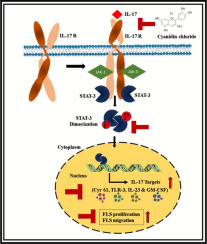当前位置:
X-MOL 学术
›
Toxicol. Appl. Pharmacol.
›
论文详情
Our official English website, www.x-mol.net, welcomes your
feedback! (Note: you will need to create a separate account there.)
Cyanidin prevents the hyperproliferative potential of fibroblast-like synoviocytes and disease progression via targeting IL-17A cytokine signalling in rheumatoid arthritis.
Toxicology and Applied Pharmacology ( IF 3.3 ) Pub Date : 2020-02-07 , DOI: 10.1016/j.taap.2020.114917 Snigdha Samarpita 1 , Ramamoorthi Ganesan 2 , Mahaboobkhan Rasool 1
Toxicology and Applied Pharmacology ( IF 3.3 ) Pub Date : 2020-02-07 , DOI: 10.1016/j.taap.2020.114917 Snigdha Samarpita 1 , Ramamoorthi Ganesan 2 , Mahaboobkhan Rasool 1
Affiliation

|
The hyperplastic phenotype of fibroblast-like synoviocytes (FLSs) plays an important role for synovitis, chronic inflammation and joint destruction in rheumatoid arthritis (RA). Interleukin 17A (IL-17A), a signature pro-inflammatory cytokine effectively influences the hyperplastic transformation of FLS cells and synovial pannus growth. IL-17A cytokine signalling participates in RA pathology by regulating an array of pro-inflammatory mediators and osteoclastogenesis. Cyanidin, a key flavonoid inhibits IL-17A/IL-17 receptor A (IL-17RA) interaction and alleviates progression and disease severity of psoriasis and asthma. However, the therapeutic efficacy of cyanidin on IL-17A cytokine signalling in RA remains unknown. In the present study, cyanidin inhibited IL-17A induced migratory and proliferative capacity of FLS cells derived from adjuvant-induced arthritis (AA) rats. Cyanidin treatment reduced IL-17A mediated reprogramming of AA-FLS cells to overexpress IL-17RA. In addition, significantly decreased expression of IL-17A dependent cyr61, IL-23, GM-CSF, and TLR3 were observed in AA-FLS cells in response to cyanidin. At the molecular level, cyanidin modulated IL-17/IL-17RA dependent JAK/STAT-3 signalling in AA-FLS cells. Importantly, cyanidin activated PIAS3 protein to suppress STAT-3 specific transcriptional activation in AA-FLS cells. Cyanidin treatment to AA rats attenuated clinical symptoms, synovial pannus growth, immune cell infiltration, and bone erosion. Cyanidin reduced serum level of IL-23 and GM-CSF and expression of Cyr 61 and TLR3 in the synovial tissue of AA rats. Notably, the level of p-STAT-3 protein was significantly decreased in the synovial tissue of AA rats treated with cyanidin. This study provides the first evidence that cyanidin can be used as IL-17/17RA signalling targeting therapeutic drug for the treatment of RA and this need to be investigated in RA patients.
中文翻译:

矢车菊素通过靶向类风湿性关节炎中的IL-17A细胞因子信号传导来阻止成纤维细胞样滑膜细胞的过度增殖潜力和疾病进展。
成纤维样滑膜细胞(FLSs)的增生表型在类风湿关节炎(RA)中对滑膜炎,慢性炎症和关节破坏起重要作用。白细胞介素17A(IL-17A)是一种标志性促炎细胞因子,可有效影响FLS细胞的增生性转化和滑膜pan的生长。IL-17A细胞因子信号传导通过调节一系列促炎性介质和破骨细胞生成而参与RA病理。关键类黄酮氰胺抑制IL-17A / IL-17受体A(IL-17RA)的相互作用,并减轻牛皮癣和哮喘的病情发展和疾病严重程度。然而,花青素对RA中IL-17A细胞因子信号传导的治疗功效仍然未知。在目前的研究中,花青素抑制IL-17A诱导的FLS细胞的迁移和增殖能力,该FLS细胞来源于佐剂诱导的关节炎(AA)大鼠。氰胺处理减少了IL-17A介导的AA-FLS细胞重编程,从而过表达IL-17RA。另外,在对花青素的应答中,在AA-FLS细胞中观察到IL-17A依赖性cyr61,IL-23,GM-CSF和TLR3的表达显着降低。在分子水平上,花青素调节AA-FLS细胞中依赖IL-17 / IL-17RA的JAK / STAT-3信号传导。重要的是,花青素激活了PIAS3蛋白,以抑制AA-FLS细胞中的STAT-3特异性转录激活。氰胺对AA大鼠的治疗减弱了临床症状,滑膜pan生长,免疫细胞浸润和骨侵蚀。氰胺降低了AA大鼠滑膜组织中IL-23和GM-CSF的血清水平以及Cyr 61和TLR3的表达。值得注意的是,用花青素处理的AA大鼠的滑膜组织中p-STAT-3蛋白的水平显着降低。这项研究提供了第一个证据,证明花青素可以用作IL-17 / 17RA信号转导靶定性治疗RA的治疗药物,需要在RA患者中进行研究。
更新日期:2020-02-07
中文翻译:

矢车菊素通过靶向类风湿性关节炎中的IL-17A细胞因子信号传导来阻止成纤维细胞样滑膜细胞的过度增殖潜力和疾病进展。
成纤维样滑膜细胞(FLSs)的增生表型在类风湿关节炎(RA)中对滑膜炎,慢性炎症和关节破坏起重要作用。白细胞介素17A(IL-17A)是一种标志性促炎细胞因子,可有效影响FLS细胞的增生性转化和滑膜pan的生长。IL-17A细胞因子信号传导通过调节一系列促炎性介质和破骨细胞生成而参与RA病理。关键类黄酮氰胺抑制IL-17A / IL-17受体A(IL-17RA)的相互作用,并减轻牛皮癣和哮喘的病情发展和疾病严重程度。然而,花青素对RA中IL-17A细胞因子信号传导的治疗功效仍然未知。在目前的研究中,花青素抑制IL-17A诱导的FLS细胞的迁移和增殖能力,该FLS细胞来源于佐剂诱导的关节炎(AA)大鼠。氰胺处理减少了IL-17A介导的AA-FLS细胞重编程,从而过表达IL-17RA。另外,在对花青素的应答中,在AA-FLS细胞中观察到IL-17A依赖性cyr61,IL-23,GM-CSF和TLR3的表达显着降低。在分子水平上,花青素调节AA-FLS细胞中依赖IL-17 / IL-17RA的JAK / STAT-3信号传导。重要的是,花青素激活了PIAS3蛋白,以抑制AA-FLS细胞中的STAT-3特异性转录激活。氰胺对AA大鼠的治疗减弱了临床症状,滑膜pan生长,免疫细胞浸润和骨侵蚀。氰胺降低了AA大鼠滑膜组织中IL-23和GM-CSF的血清水平以及Cyr 61和TLR3的表达。值得注意的是,用花青素处理的AA大鼠的滑膜组织中p-STAT-3蛋白的水平显着降低。这项研究提供了第一个证据,证明花青素可以用作IL-17 / 17RA信号转导靶定性治疗RA的治疗药物,需要在RA患者中进行研究。











































 京公网安备 11010802027423号
京公网安备 11010802027423号